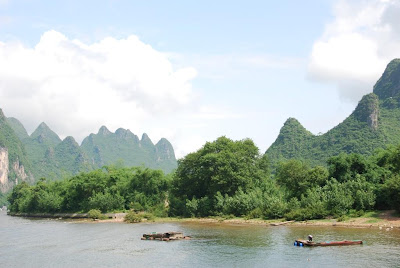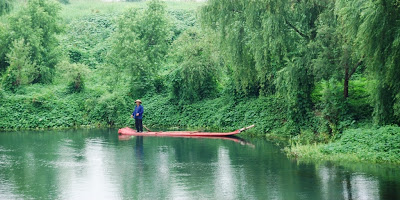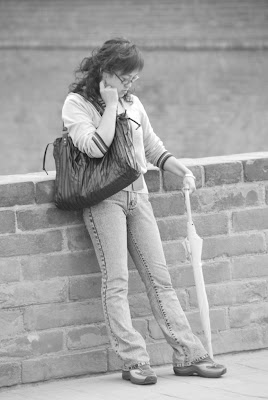On the Rio: Beck~ Tropicalia
The mausoleum of Qin Shi Huang, the first Emperor of all China who ascended the throne at the age of 13 (in 246 BC) includes life size terracotta figures of warriors and horses arranged in battle formations.
Altogether over 7,000 pottery soldiers, horses, chariots, and even weapons have been unearthed from these pits. Most of them have been restored to their former grandeur.

The pits provide an incredible amount of information of the army's forces, dispositions such as the distribution and formation of ranks, the use of weapons and the application of military tactics. The
terra cotta soldiers are remarkably realistic sculptures. The figures are mostly 1.8 meters (5 feet 11 inches) in height, the lower part of the body being solid and the upper part hollow. Originally the figures were painted in bright colors however, over the two thousand years they have silently stood guard, the color has faded and worn off.
 An abundance of clay and especially large deposits of ochre-colored loess in Northern China, which the Chinese refer to as 'yellow earth' proved to be a suitable material due to its plasticity and adhesive quality.
An abundance of clay and especially large deposits of ochre-colored loess in Northern China, which the Chinese refer to as 'yellow earth' proved to be a suitable material due to its plasticity and adhesive quality. 
The clay was firstly panned and crushed into a malleable form is suitable for molding. The mould was started from the bottom of the body. The feet of the warrior were formed on a square base, and legs were then added. When half-dry, clay was coiled into 3 to 5 cm ropes wound upwards to create the hollow upper body. This was carefully smoothed using a paddle on the exterior pressing against an anvil or block on the inside wall. Next, the half finished head and hands were pasted onto the body. The structure of the base prevented the figure from collapsing. Fashioning heads represented a complicated process. Facial features were achieved using a mould, with piling and sculpting to form the back. Ears were pasted to the heads prior to adding sculpted or molded hair buns.

A procedure was adopted to give individuality to each rough mould. The artisans smeared fine clay on the rough surface, then by pinching, pasting, cutting, and carving, facial details like eyes, hair, moustache, ears were elaborately represented. Excavations indicate that dozens of heads might be made from the same mould.

Skillful refinement produced the individual life like facial features and impressive stance, representative of the powerful Qin army. No two figures have an identical face; some appear solemn in deep thought while others are of a cheerful countenance. Archaeological research confirms that these facial features are truly representative of the real men.
A two wheeled chariot with a round canopy, 1.2 meters in length and 1.3 meters in width, is pulled by four pottery horses flanked by two spear men with a central charioteer. The horses measure 1.5 meters (4 feet 11 inches) in height and 2 meters (6 feet 7 inches) in length. The charioteer wears a long robe under armor that protects his chest, back and shoulders. His arm extends forward as if he is holding reins.
















 The highlight is the natural formation resembling a huge elephant drinking water from the Li River.
The highlight is the natural formation resembling a huge elephant drinking water from the Li River. 



 There were some plant art exhibits as well, for those of you who remember the pictures I took in Shanghai last year. This is an elephant family (elephants are very prominant in Guilin).
There were some plant art exhibits as well, for those of you who remember the pictures I took in Shanghai last year. This is an elephant family (elephants are very prominant in Guilin).
 Next there was a Pavilion with the all too familiar bell. "Kuishui" is the ancient name of the river running through the city (and I took a cruise down the next day) now known as the Lijiang River.
Next there was a Pavilion with the all too familiar bell. "Kuishui" is the ancient name of the river running through the city (and I took a cruise down the next day) now known as the Lijiang River. I had to actually climb a hill. Boy, am I out of shape compared to when I hiked the Great Wall. I barely could make it up all the stairs; maybe it was the humidity, but I'll blame it on my winter inactivity and beer drinking. (If you see the import beer "Harbin" anywhere in the U.S. I highly recommend it - as it has German influences).
I had to actually climb a hill. Boy, am I out of shape compared to when I hiked the Great Wall. I barely could make it up all the stairs; maybe it was the humidity, but I'll blame it on my winter inactivity and beer drinking. (If you see the import beer "Harbin" anywhere in the U.S. I highly recommend it - as it has German influences).
 I especially liked the leisurly life of the riverboat man.
I especially liked the leisurly life of the riverboat man. Then I went to Thousand Buddha Cave. It was an actual Buddhish temple in the caves, complete with everything! Totally fascinating. The cave is actually two structures, with the upper level being more than 20 meters long (why is the US not on the metric system?)
Then I went to Thousand Buddha Cave. It was an actual Buddhish temple in the caves, complete with everything! Totally fascinating. The cave is actually two structures, with the upper level being more than 20 meters long (why is the US not on the metric system?)
 Sadly, the empty spaces are carvings that have been stolen over the years.
Sadly, the empty spaces are carvings that have been stolen over the years.
 I went wandering around Shanghai to see any interesting sites that remain before I depart (only one week to go!).
I went wandering around Shanghai to see any interesting sites that remain before I depart (only one week to go!).


 The pits provide an incredible amount of information of the army's forces, dispositions such as the distribution and formation of ranks, the use of weapons and the application of military tactics. The
The pits provide an incredible amount of information of the army's forces, dispositions such as the distribution and formation of ranks, the use of weapons and the application of military tactics. The  An abundance of clay and especially large deposits of ochre-colored
An abundance of clay and especially large deposits of ochre-colored 





 Here is my guide Wendy.
Here is my guide Wendy.
 After the East Gate, I went to Banpo Village, an archeological site from 5000 B.C., built by a late Neolithic people.
After the East Gate, I went to Banpo Village, an archeological site from 5000 B.C., built by a late Neolithic people. Banpo had about sixty buildings and housed over 200 people from two clans. It was a matriarchal society based on farming. The houses were thatch over wood beams while the floors were sunk 2 to 3 feet into the ground. Heat was provided by a central fire for the family. They stored food in underground caves, dug deep enough to protect it from wildlife and insects.
Banpo had about sixty buildings and housed over 200 people from two clans. It was a matriarchal society based on farming. The houses were thatch over wood beams while the floors were sunk 2 to 3 feet into the ground. Heat was provided by a central fire for the family. They stored food in underground caves, dug deep enough to protect it from wildlife and insects.  Art, in the form of geometric designs and human and animal figures is found on many of their pots. The village had their own pottery which produced specialized pots for drinking, storage, cooking, and burial. This is a symbolic totem at the village entrance.
Art, in the form of geometric designs and human and animal figures is found on many of their pots. The village had their own pottery which produced specialized pots for drinking, storage, cooking, and burial. This is a symbolic totem at the village entrance. Adults were buried in the cemetery outside the village, some alone, some in pairs, or in groups such as this.
Adults were buried in the cemetery outside the village, some alone, some in pairs, or in groups such as this.
 And here's a self-portrait of me on my birthday last month.
And here's a self-portrait of me on my birthday last month.
